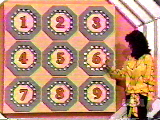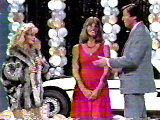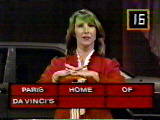

Front Game Rules | ||
 | ||
| Three players competed. Each contestant began with a bankroll of $20. Host Perry read the players a series of questions. A player could buzz in in the middle of the reading of a question. Answering correctly added $5 to the contestant's score; answering wrong lost $5. | 
| |

| At three points during the game, the player in the lead was treated to an "Instant Bargain", which offered the contestant a prize at an unbelievably low price, to be deducted from the player's score if bought. (For instance, an $800 stereo system for just $8.) If the player refused the bargain, Perry would occasionally add money or drop the price of the prize. If two or more players tied for the lead, the prize was auctioned off. Partway through the run, the third Instant Bargain became "Instant Ca$h", which offered a chance at a growing cash jackpot. | |
| Alternating with the Instant Bargains was another feature known as the "Fame Game". During the Fame Game, Perry read a series of clues leading up to a person, place or thing. The player who buzzed in with right answer got a pick from a board of nine panels (originally bearing the faces of celebrities), each concealing a prize, cash, or a "Money Card" which added $10, $15, or even $25 to the player's score. Later, a contestant chose a number off the board by stopping the light that flashed randomly around the board with his/her buzzer. (The money cards were visible in this case.)
The game culminated with a 60-second speed round, with questions again worth +/-$5. After the speed round, the player with the most money won the game and advanced to the next round. The other players left with the amount won in their scores. | 
| |
End Game Rules | ||

| Three separate end games were played during the 80s. Originally, the winner got to browse through a showroom filled with valuable prizes (often including a trip, a car, and a boat). The player then had to make a decision to either buy a prize on the stage and retire, or hold the money on account and return the next day, at the risk of losing the next game and thus the chance to go shopping again. If a player could win enough games to amass $750, he/she won every prize on stage, as well as a cash jackpot that begins at $50,000 and grows by $1000 for each day it isn't won. | |
| Later, the end game was changed. The player was shown a board with 20 cards, each bearing either a prize or the word "WIN". The player called out numbers until two of the same prize was revealed. The "WIN" card was wild and served to match the next card turned over. Hidden among the cards were one card each with a car or $10,000: the "WIN" card had to be used to win either of those. | ||
Still later, the end game changed again into a bonus round. The contestant selected one of three packets, each with 6 word puzzles. Each puzzle had 6 one-word clues, which were revealed one at a time until the player hit a plunger and stopped the clock. The player had 25 seconds to solve five of the six puzzles. The first attempt at the bonus round was for $5000, and each subsequent visit to the end game was worth $1000. The seventh trip to the bonus round was for a new car. | 
| |
Listen, game show scholars, and listen well. If you're producing a good game show and the network suits want you to start tinkering with the format to save on the budget, take the show off that network and into syndication. "Saving the budget", in the case of SotC, meant cutting out the very essence of the game. The very concept is that of buy now or save for later, a sentiment that was hit home when the champion shopped for the larger prizes at the end. Switching to the player picking numbers off a board, and later to a totally noncogent bonus round, turned the endgame from great to passable to horrid. Jim Perry, however, was the perfect host for this show. Not only is a great question reader who can cut his reading on a dime, but he added flair to the show as well. I loved how he worked the Instant Bargains, and how he'd punctuate the decision with his saying "Going once... going TWICE..."